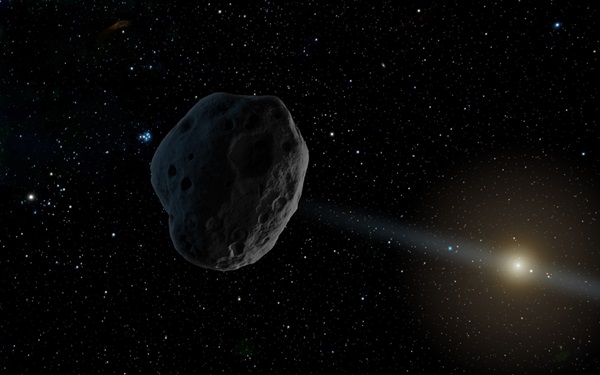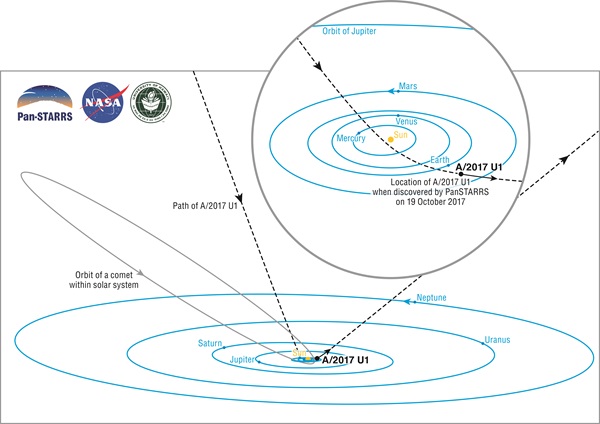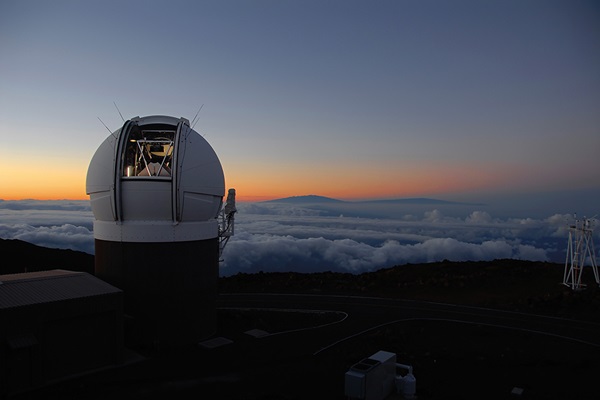Key Takeaways:
For an example of the prophetic powers of science, check out the February 1997 issue of Astronomy. In the article “Seeking Rogue Comets,” planetary scientist Alan Stern confidently predicted that astronomers would someday discover an interstellar comet — an object that was unceremoniously flung out of another planetary system during a close encounter with a giant planet, and was found whizzing through our solar system at high speed on an open-ended, hyperbolic trajectory.
“We had a pretty good idea this was coming,” says Stern, who is now the principal investigator of NASA’s New Horizons mission to Pluto and the Kuiper Belt.
Stern would have to wait 20 years for his prediction to come true. But when it did, it led to a flurry of activity as large telescopes swung into action to take data during the brief period when the object was close enough to Earth to be visible.
The discovery itself occurred on the night of October 19, when University of Hawaii astronomer Rob Weryk noticed an unusual 20th-magnitude streak in Pisces in images taken with the 1.8-meter Pan-STARRS 1 telescope. After spotting the same object in images taken the previous night, he contacted European Space Agency astronomer Marco Micheli. Sure enough, his telescope in the Canary Islands had caught it too.
“Its motion could not be explained using either a normal solar system asteroid or comet orbit,” says Weryk. “When both our datasets were fit together, it became clear that the only explanation was a hyperbolic trajectory.”
“It is going extremely fast and on such a trajectory that we can say with confidence that this object is on its way out of the solar system and is not coming back,” adds Davide Farnocchia of NASA’s Center for Near-Earth Object Studies.
The Minor Planet Center has just given this interstellar interloper the permanent designation 1I/‘Oumuamua. The Pan-STARRS team chose this Hawaiian name to signify the object’s “scout” or “messenger” characteristics.
1I/‘Oumuamua’s velocity and direction of origin match very closely the predictions made by Stern and other astronomers decades earlier. The object entered the solar system with a speed of 25.5 kilometers per second (57,000 mph), smack dab in the middle of Stern’s predicted range of 20 to 30 km/s. And the interloper is coming from the direction of Lyra, just a few degrees from the Sun’s line of motion through interstellar space — the area where we’d expect to find the most interlopers.
“We had a pretty good idea this was coming,” says Stern, who is now the principal investigator of NASA’s New Horizons mission to Pluto and the Kuiper Belt.
Stern would have to wait 20 years for his prediction to come true. But when it did, it led to a flurry of activity as large telescopes swung into action to take data during the brief period when the object was close enough to Earth to be visible.
The discovery itself occurred on the night of October 19, when University of Hawaii astronomer Rob Weryk noticed an unusual 20th-magnitude streak in Pisces in images taken with the 1.8-meter Pan-STARRS 1 telescope. After spotting the same object in images taken the previous night, he contacted European Space Agency astronomer Marco Micheli. Sure enough, his telescope in the Canary Islands had caught it too.
“Its motion could not be explained using either a normal solar system asteroid or comet orbit,” says Weryk. “When both our datasets were fit together, it became clear that the only explanation was a hyperbolic trajectory.”
“It is going extremely fast and on such a trajectory that we can say with confidence that this object is on its way out of the solar system and is not coming back,” adds Davide Farnocchia of NASA’s Center for Near-Earth Object Studies.
The Minor Planet Center has just given this interstellar interloper the permanent designation 1I/‘Oumuamua. The Pan-STARRS team chose this Hawaiian name to signify the object’s “scout” or “messenger” characteristics.
1I/‘Oumuamua’s velocity and direction of origin match very closely the predictions made by Stern and other astronomers decades earlier. The object entered the solar system with a speed of 25.5 kilometers per second (57,000 mph), smack dab in the middle of Stern’s predicted range of 20 to 30 km/s. And the interloper is coming from the direction of Lyra, just a few degrees from the Sun’s line of motion through interstellar space — the area where we’d expect to find the most interlopers.
By following 1I/‘Oumuamua’s path, astronomers could trace its entire trajectory through our solar system. It entered from almost directly “above” the ecliptic. On September 2, it crossed under the ecliptic just inside Mercury’s orbit and came closest to the Sun on September 9. The Sun’s gravity sharply deflected its path and boosted its velocity. The interloper swung closest to Earth on October 14 at a range of 24 million km, when it was moving across the sky at an astonishing clip of 12 degrees per day. It’s now shooting back up above the ecliptic at 44 km/sec and heading toward Pegasus.
Because of 1I/‘Oumuamua’s blazing speed, astronomers could only follow it for about 10 days. It never showed any signs of activity, and because it never grew brighter than magnitude 19.7, astronomers could only take crude spectra. They revealed a reddish color but no detailed compositional information. The color, along with its lack of activity, suggests that its composition is more asteroidal than cometary.
But UCLA astronomer David Jewitt cautions that its lack of activity and reddish color just means that the upper layers contained no materials that could be easily vaporized. “We can say nothing about the deep interior, so there’s not a lot we can say about the physical nature of the body,” says Jewitt.
Even the size is poorly known. Lacking detailed information about the object’s reflectivity, about all that astronomers can say is that it’s a few hundred meters across.
Although Stern predicted the general contours of this discovery, he expected the first interstellar object to be seen farther away.
“I did not expect us to find one that came into the inner solar system as our first find,” recalls Stern. “As you go farther and farther out, the target area gets bigger and bigger. My calculations had indicated that the most likely first detection would come at a distance of 10 to 30 AU, depending on telescope capabilities. Pan-STARRS found it very close to Earth, which was surprising to me. Close-range flybys of Earth should be much rarer than more distant objects. It might mean that there are a lot more of these.”
Stern predicts that 1I/‘Oumuamua is just the opening salvo in the study of a new class of objects. He likens the discovery to that of the first Kuiper Belt objects in the early 1990s. The first finding, by David Jewitt and Jane Luu in 1992, ultimately led to a flood of KBOs, and now we have thousands. Stern even suggests that more interstellar objects could be lurking in archival Pan-STARRS data and could turn up once the team fine-tunes its search software.
Weryk agrees. “We certainly hope to find more,” he says. “Now that we know these objects exist, we’ll try to tune our survey strategy to increase our chances of finding another. I am very interested in searching the Pan-STARRS archive for more objects, but that will take some effort.”
Just a brief glimpse
Because of 1I/‘Oumuamua’s blazing speed, astronomers could only follow it for about 10 days. It never showed any signs of activity, and because it never grew brighter than magnitude 19.7, astronomers could only take crude spectra. They revealed a reddish color but no detailed compositional information. The color, along with its lack of activity, suggests that its composition is more asteroidal than cometary.
But UCLA astronomer David Jewitt cautions that its lack of activity and reddish color just means that the upper layers contained no materials that could be easily vaporized. “We can say nothing about the deep interior, so there’s not a lot we can say about the physical nature of the body,” says Jewitt.
Even the size is poorly known. Lacking detailed information about the object’s reflectivity, about all that astronomers can say is that it’s a few hundred meters across.
Although Stern predicted the general contours of this discovery, he expected the first interstellar object to be seen farther away.
“I did not expect us to find one that came into the inner solar system as our first find,” recalls Stern. “As you go farther and farther out, the target area gets bigger and bigger. My calculations had indicated that the most likely first detection would come at a distance of 10 to 30 AU, depending on telescope capabilities. Pan-STARRS found it very close to Earth, which was surprising to me. Close-range flybys of Earth should be much rarer than more distant objects. It might mean that there are a lot more of these.”
Stern predicts that 1I/‘Oumuamua is just the opening salvo in the study of a new class of objects. He likens the discovery to that of the first Kuiper Belt objects in the early 1990s. The first finding, by David Jewitt and Jane Luu in 1992, ultimately led to a flood of KBOs, and now we have thousands. Stern even suggests that more interstellar objects could be lurking in archival Pan-STARRS data and could turn up once the team fine-tunes its search software.
Weryk agrees. “We certainly hope to find more,” he says. “Now that we know these objects exist, we’ll try to tune our survey strategy to increase our chances of finding another. I am very interested in searching the Pan-STARRS archive for more objects, but that will take some effort.”
Only the beginning
Nobody has a firm handle on how many such objects exist in our galaxy, but the numbers must be staggering. According to Stern, Jupiter, Saturn, Uranus, and Neptune combined probably ejected 1013 to 1014 objects larger than 1 km early in our solar system’s history, when it was still cluttered with debris left over from the planet-formation process. Multiply that by the 1011 stars in the Milky Way, and one comes up with numbers like 1024 to 1025 objects larger than a kilometer. Smaller objects like 1I/‘Oumuamua must be orders of magnitude more plentiful. But our galaxy’s volume of space is so enormous that catching an interstellar interloper in the solar system is like finding a needle in a haystack.
When the 8-meter Large Synoptic Survey Telescope comes online around 2021, its deep reach over large swathes of sky will undoubtedly reveal scads of interlopers. “We have the potential to study a lot of these objects. However, to do this efficiently really requires larger follow-up telescopes, such as the 30- to 40-meter-class telescopes now being built,” says Weryk’s University of Hawaii colleague Karen Meech.
“When we have seen more of these objects, it will be interesting to see if most are asteroidal or cometary,” adds Stern. Because the giant planets in our solar system are far from the Sun, they ejected primarily icy (cometary) objects. If it turns out that most interstellar objects are rocky, that could indicate that most planetary system that eject small bodies have giant planets closer to their host stars.
Astronomers will also be interested in learning the size distribution of interstellar objects, and whether some of them have satellites. They will also learn about their rotation rates and reflectivity.
Stern emphasizes that these objects come from very distant stars. They have been orbitally mixed over billions of years, so they represent a statistical sample of what is coming out of all the planetary systems that exist in the galaxy.
“It’s a little bit like pollen in the wind,” explains Stern. “Even if you don’t have any trees in your yard that produce pollen, you’ll still see pollen blowing through the wind from faraway trees. By studying the pollen, you can learn about the population of trees that are generating it. Now we’re going to start getting the statistical sample of all the ejecta from all the other planetary systems in the Milky Way Galaxy.”
Nobody has a firm handle on how many such objects exist in our galaxy, but the numbers must be staggering. According to Stern, Jupiter, Saturn, Uranus, and Neptune combined probably ejected 1013 to 1014 objects larger than 1 km early in our solar system’s history, when it was still cluttered with debris left over from the planet-formation process. Multiply that by the 1011 stars in the Milky Way, and one comes up with numbers like 1024 to 1025 objects larger than a kilometer. Smaller objects like 1I/‘Oumuamua must be orders of magnitude more plentiful. But our galaxy’s volume of space is so enormous that catching an interstellar interloper in the solar system is like finding a needle in a haystack.
When the 8-meter Large Synoptic Survey Telescope comes online around 2021, its deep reach over large swathes of sky will undoubtedly reveal scads of interlopers. “We have the potential to study a lot of these objects. However, to do this efficiently really requires larger follow-up telescopes, such as the 30- to 40-meter-class telescopes now being built,” says Weryk’s University of Hawaii colleague Karen Meech.
“When we have seen more of these objects, it will be interesting to see if most are asteroidal or cometary,” adds Stern. Because the giant planets in our solar system are far from the Sun, they ejected primarily icy (cometary) objects. If it turns out that most interstellar objects are rocky, that could indicate that most planetary system that eject small bodies have giant planets closer to their host stars.
Astronomers will also be interested in learning the size distribution of interstellar objects, and whether some of them have satellites. They will also learn about their rotation rates and reflectivity.
Stern emphasizes that these objects come from very distant stars. They have been orbitally mixed over billions of years, so they represent a statistical sample of what is coming out of all the planetary systems that exist in the galaxy.
“It’s a little bit like pollen in the wind,” explains Stern. “Even if you don’t have any trees in your yard that produce pollen, you’ll still see pollen blowing through the wind from faraway trees. By studying the pollen, you can learn about the population of trees that are generating it. Now we’re going to start getting the statistical sample of all the ejecta from all the other planetary systems in the Milky Way Galaxy.”
Interstellar objects have been roaming the frigid depths of space for eons, with few evolutionary forces acting upon them. In other words, they are objects that have been stored in deep freeze. “They are well-preserved examples of things made in other star systems,” says Stern. “For that reason, they’re going to be valuable as the population is studied.”
1I/‘Oumuamua is not the first interstellar object ever detected in the solar system per se; it’s the first macroscopic object. Astronomers have previously detected cosmic rays, gas, and ions, and they have even collected interstellar dust grains.












